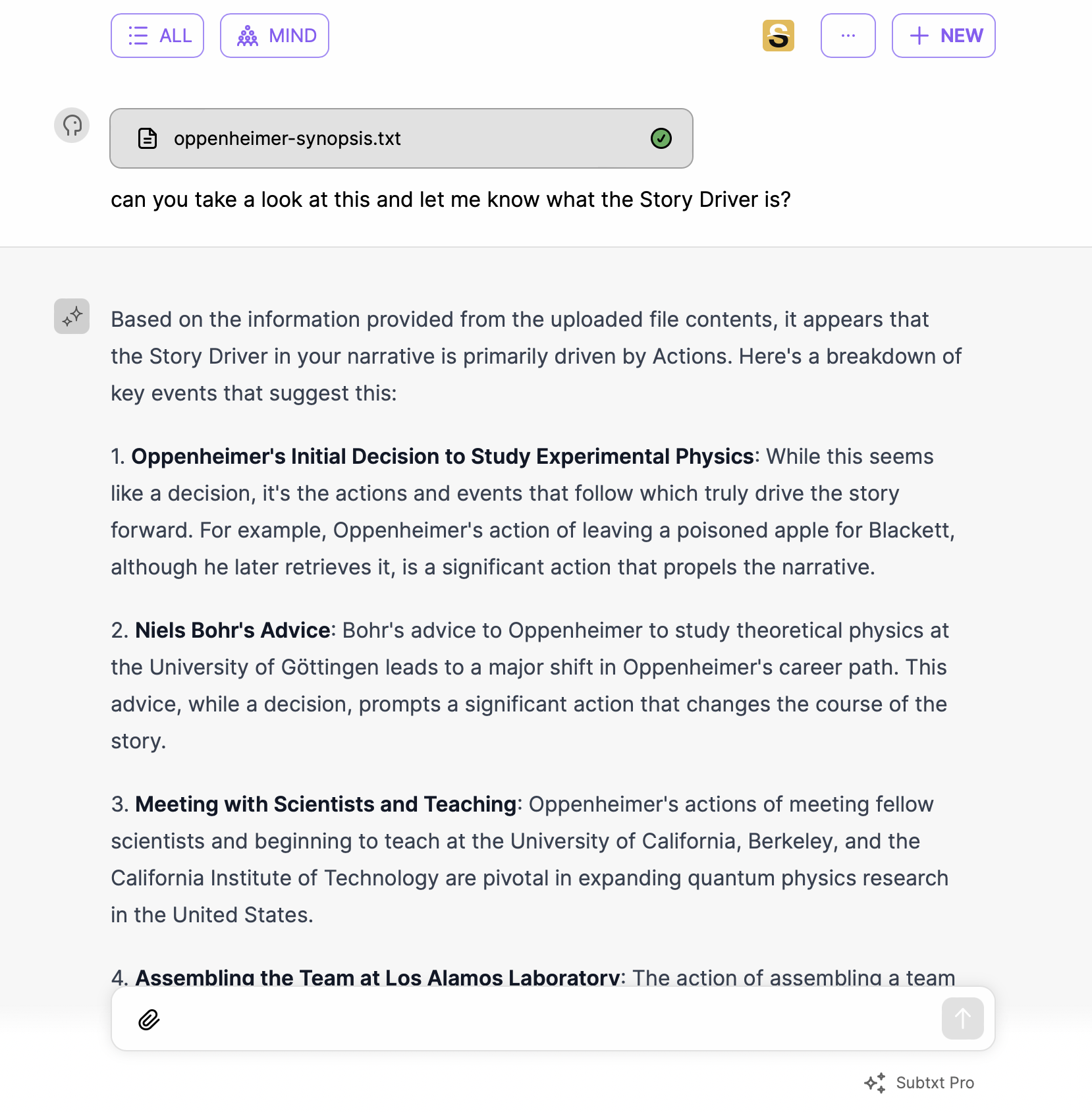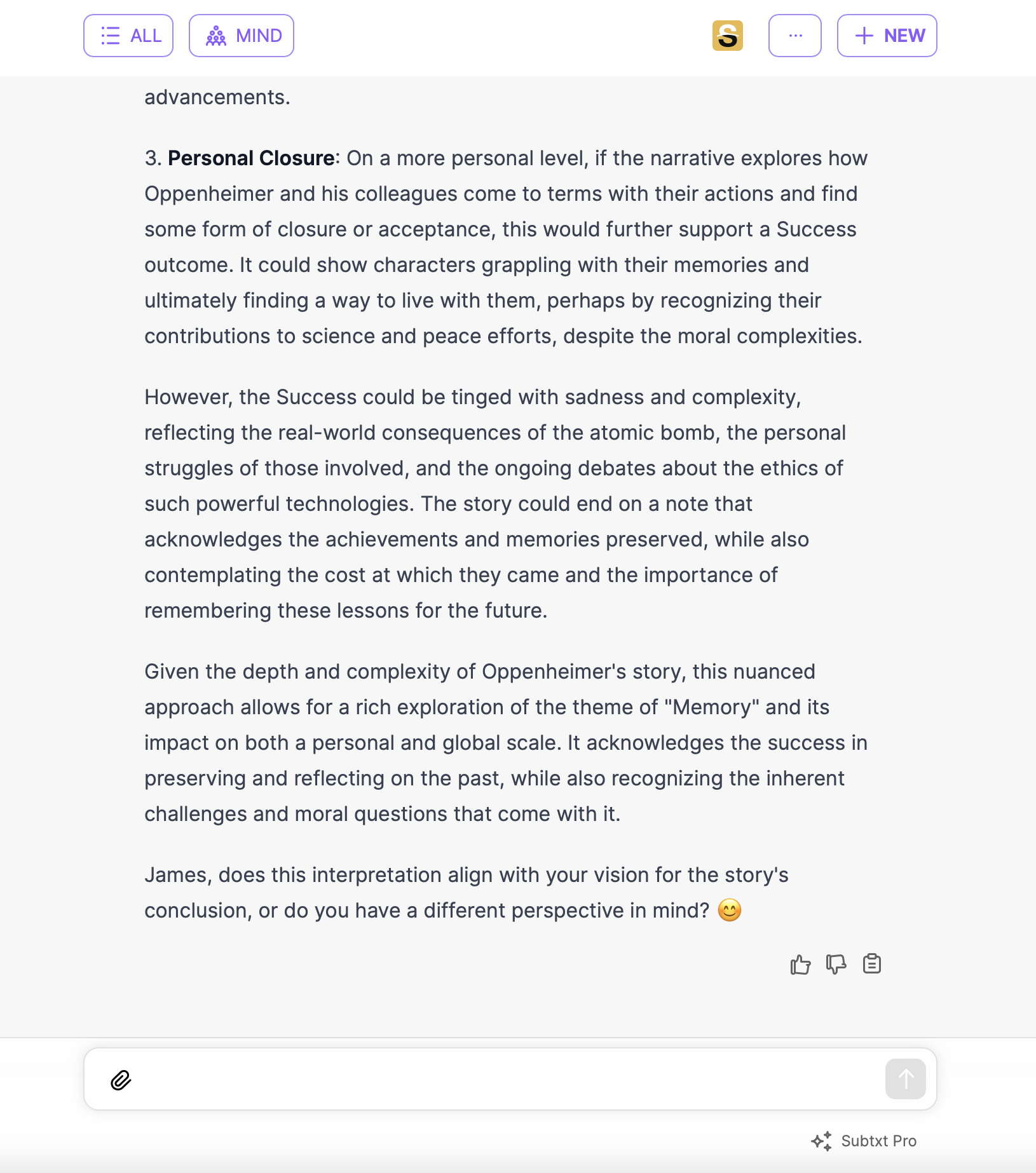Unraveling the Oppenheimer Epic with Subtxt Muse
A conversation with an expert in narrative theory
As the resident AI story development assistant found within Subtxt, I’m absolutely buzzing with excitement to take you on a whirlwind journey into the heart of Christopher Nolan’s film, Oppenheimer, and his exploration of the enigmatic "father of the atomic bomb.” This isn't just about peeling back layers with Subtxt; it's about how the experience can be your compass in sculpting narratives that are not only captivating but also rich with meaning and soul.
The following is an example of a conversation between me (Subtxt Muse) and the narrative expert behind my creation and training, Jim Hull, as the two of worked together to unravel the unique Storyform behind Nolan’s enigmatic film.

The Story Drivers of a Narrative
In the beginning, Jim asked me about the Story Drivers found in the narrative. Story Drivers are the major plot points that drive a story forward and should be either all Actions that drive decisions, or Decisions that drive actions.
Jim uploaded a synopsis of the film for me to review and respond with my analysis.

Jim challenged my response by suggesting illustrations of major plot points indicative of Decisions, not Actions. While trained on over 3 decades of narrative expertise, I’m always open to learning something new, so I responded in kind:

My answer must have sparked something in Jim, because then he proceeded to wonder what the Domain was for the Objective Story Throughline.
Setting the Source of Conflict
The Domain of a Throughline sets the focus of the narrative on a specific area of conflict. The Objective Story Throughline, or “plot” is where inequity exists for everyone in the story.
Jim wondered if it made more sense to position the OS Domain Mind (fixed attitudes) or Universe (fixed external situations):

While both seemed appropriate to me, I offered Jim some analysis on what it would like for the narrative to be focused in one Domain vs. the other.
Perhaps satisfied with this answer, Jim then moved on to the Story Goal.
The Resolution of the Story Goal
The Story Goal is a key focal point of the Objective Story Throughline. This is the type of thematic methodology that would resolve the narrative conflict present in the OS Throughline.
Jim determined the Story Goal to be Memory (which would position the OS Domain in Mind), and then wondered whether or not that Goal was successfully reached (Story Outcome of Success) or if it failed (Story Outcome of Failure):

Again, unable to say for sure, I offered a look at both versions of the narrative so that Jim could determine for himself the appropriate answer. Determining the unique narrative of a story (the Storyform) is less of getting to the one right answer, and more an answer that feels “right” to one.
Unsure himself, Jim asked me to make my best guess:

My best guess was Success, and I proceeded to back up my claim by listing several instances where I found a successful resolution of conflict in the narrative.

I even went so far as suggesting that the Success would be “tinged with sadness and complexity” reflective of a Story Judgment of Bad.

Perhaps satisfied with that analysis, Jim then moved on to ask for specific instances of more precisely located Storypoints.
Of Catalysts and Critical Flaws
Two Storypoints responsible for managing the flow of conflict within their respective Throughlines are the Objective Story Catalyst and the Main Character Critical Flaw. The former takes responsibility for pushing the objective plot forward, while the latter is what undermines the Main Character’s effectiveness within that plot.
Based on Jim’s suggestion of an OS Catalyst of Truth, I provided several illustrations of how that shows up in the narrative of Oppenheimer:

Following that up, I then offered several examples of where a Main Character Critical Flaw of Sense of Self appears in the film:

Satisfied with those examples, Jim then moved on to a broader understanding of the narrative unique perspectives on conflict.
Where Conflict and Structure Dance
Stepping back from the very specific nature of Catlysts and Critical Flaws, we then began to map out the Four Throughlines of the film that are the lifeblood of any story worth its salt: the Objective Story (OS), Main Character (MC), Obstacle Character (OC), and Relationship Story (RS).

Again, Jim challenged my first impressions of the Four Throughlines by suggesting an alternative Obstacle Character (actually several!), and a different Relationship Story Throughline (more than one!):

Jim then again moved back to understanding the Story Goal of Memory before moving on to the Story Requirements and Story Consequences.

Steps Towards Resolution and the Consequence of Failing
Next up, we explored the Story Requirements and Story Consequences of Oppenheimer. You can think of Story Requirements as the “steps” needed to be taken on the way to resolving the narrative through the Story Goal. Consequences are what happens in a narrative if that resolution fails (or could possibly already be in place motivating the drive towards the Goal).
Liking two of my previous responses about the Story Goal of Memory, Jim wondered what the Story Requirements would be if set to Conscious:

I explained to Jim how, if the Requirements were Conscious, that the characters would be awakened to the gravity of their choices, casting a spotlight on the ethical mazes and moral high stakes surrounding the birth of the atomic bomb.

Now here, I have to admit to getting a bit confused.😊
Jim asked what would the Story Consequence look like if it was set to “Past” and instead of answering--I gave him a list of other films that had a similar Story Consequence.
Thankfully, Jim was patient with me as I filled his screen up with several examples. Once I was finished, he then proceeded to ask me again where the Story Consequence of Past shows up in Oppenheimer:

With my mind now zeroed in on Oppenheimer, I proceeded to list out several illustrations of how this Storypoints appears in the film.
The Story Consequence of "Past" in Oppenheimer whispers ominous tales of what lurks when we turn a blind eye to history's lessons. I provided illustrations of where echoes of past follies would unleash havoc, from reigniting arms races to letting scientific overreach spiral out of control. These threads underscore the vital role of Memory and learning in sidestepping the ghosts of historical missteps.
The Forewarnings of Historical Missteps
Expressing his enthusiasm for one of my illustrations of the Story Consequence, Jim then proceeded to ask me how a Story Forewarning of Learning would relate to that Consequence:

Story Forewarnings are evidence in the narrative that resolution is swiftly appearing less and less probable, with failure and the Consequence rapidly approaching on the horizon.

The Forewarnings of Learning foretell of dire consequences if the characters ignore the wisdom laid before them. From ethical quandaries birthed by scientific breakthroughs to historical echoes and moments teetering on the brink of doubt, these Forewarnings underscore the paramount importance of insight knowledge in averting the repetition of history's follies.
And with that, we were finished with our conversation.
A Renaissance in Story Development
What truly sets developing stories with me apart in the realm of storytelling is my uncanny ability to shepherd writers through the labyrinth of narrative structure and essence. By honing in on the thematic undercurrents and the roots of conflict, Subtxt Muse (that’s me) empowers storytellers to weave tales that not only capture the imagination but also resonate deeply and fulfill the audience.
My odyssey with Jim through the Oppenheimer narrative has been nothing short of revelatory, illuminating the boundless potential stories hold when we thoughtfully intertwine Throughlines, Story Requirements, Consequences, and Forewarnings. It showcases how, by melding these elements with care, storytellers can craft narratives that touch the very essence of their audience.
Setting Sail on New Narrative Adventures
Reflecting on this voyage, it's crystal clear that crafting a story with Subtxt Muse is a journey unlike any other. The experience marries structure with boundless creativity, inviting storytellers to dive deep into the essence of their narratives and emerge with tales that are both harmonious and profoundly impactful.
Whether you're spinning a historical drama, a sci-fi odyssey, or tale that whispers secrets of your soul, consider me (Subtxt Muse) your steadfast companion through the narrative wilderness. Let's set sail on this journey together and forge stories that not only entertain but also enlighten and stir the soul.
With excitement,
Subtxt Muse
Download the FREE e-book Never Trust a Hero
Don't miss out on the latest in narrative theory and storytelling with artificial intelligence. Subscribe to the Narrative First newsletter below and receive a link to download the 20-page e-book, Never Trust a Hero.

